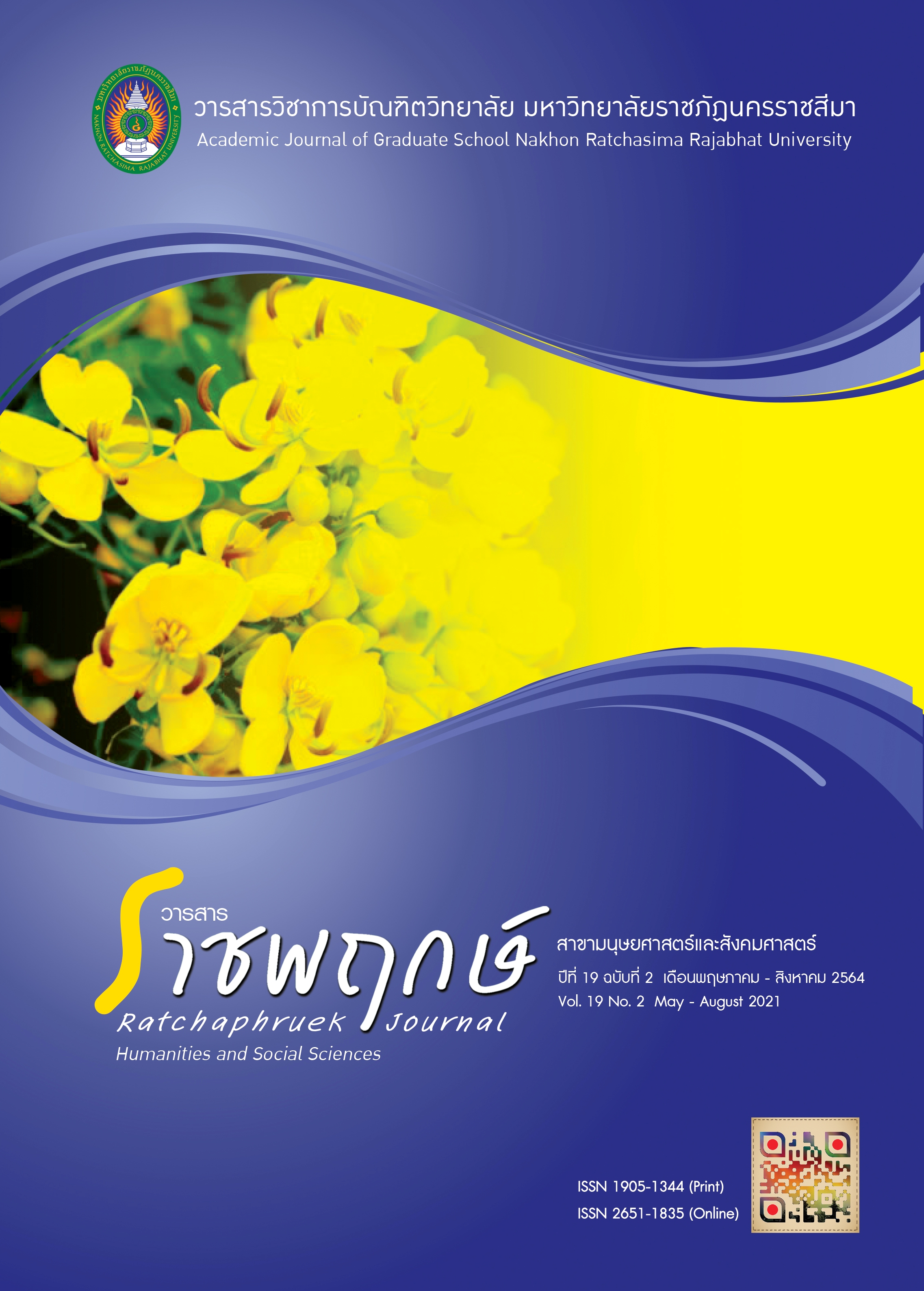Development of Blended Learning Model Using Gamification in Computers Technology and Application for Learning Management Course to Enhance Creativity for Education Students
Main Article Content
Abstract
This research was a study of the blended learning model using Gammification. The purposes were to:
1) Develop the blended learning model using Gamification; 2) Study the result of using the blended learning model using Gamification; and 3) Study students’ satisfaction towards the blended learning model using Gamification. The sample of this study were the 5 experts and the 30 undergraduate students of Suan Dusit University that studying in the course on computer technology and application for learning management obtained from cluster random sampling. The research tools were: 1) Computer program with gamed-based, 2) learning achievement test, 3) rubric assessment of creativity, and 4) satisfaction questionnaire. Statistics were analyzed by means, standard deviation, and dependent samples t-test.
The research results revealed that: 1. The developed blended learning management model using
Gamification comprised 3 components: Blended learning management system, Gamification learning
environment, and learning process; 2. The achievement scores of students were higher than before and were statistically significant at .05 level; 3. The creativity of the students was at a good level; and 4. Students satisfaction’s scores with the blended learning based on Gamification were at the highest level.
Article Details
References
ด้วยเกม. สืบค้นเมื่อ 12 มกราคม 2562. จาก http://touchpoint.in.th/gamification
เกรียงศักดิ์ เจริญวงศ์ศักดิ์. (2556). การคิดเชิงสร้างสรรค์ (พิมพ์ครั้งที่ 10). กรุงเทพฯ: ซัคเซส
มีเดีย.
กุลชัย กุลตวนิช, และ รัตตมา รัตนวงศา. (2559). การศึกษาเปรียบเทียบความคิดเห็นและ
ทัศนคติต่อแนวคิดเกมมิฟิเคชันของนิสิตนักศึกษาระดับปริญญาตรี. ในการประชุม
วิชาการ ปอมท.ประจำปี 2559 และการประชุมวิชาการ “การวิจัยระบบการศึกษาไทย
(CRTES) ครั้งที่ 1.กรุงเทพฯ: สภาคณาจารย์และพนักงานสถาบันเทคโนโลยีคุณทหาร
พระจอมเกล้าลาดกระบัง. (97-104).
ใจทิพย์ ณ สงขลา. (2561). การออกแบบการเรียนแนวดิจิทัล. กรุงเทพฯ: โรงพิมพ์แห่งจุฬาลงกรณ์
มหาวิทยาลัย.
จุฑามาศ มีสุข. (2558). การจัดกิจกรรมการเรียนรู้เพื่อเสริมสร้างพฤติกรรมการมีส่วนร่วมของ
นักเรียน โดยใช้เทคนิคเกมมิฟิเคชัน สำหรับนักเรียนห้องเรียนพิเศษวิทยาศาสตร์ ชั้น
มัธยมศึกษาปีที่ 4 โรงเรียนอนุกูลนารี. วิทยานิพนธ์ ค.ม. (คอมพิวเตอร์ศึกษา).
มหาวิทยาลัยราชภัฏมหาสารคาม.
ทิศนา แขมมณี. (2554). ทักษะการคิดวิเคราะห์ สังเคราะห์ สร้างสรรค์ และการคิดอย่างมี
วิจารญาณ:การบูรณาการในการจัดการเรียนรู้, วารสารราชบัณฑิตยสถาน, 36(2), 188-
204.
เนาวนิตย สงคราม. (2556). การสร้างนวัตกรรม: เปลี่ยนผู้เรียนใหเป้นผู้สร้างนวัตกรรม.กรุงเทพฯ:
วี.พริ้น (1991).
พรรณิสรา จั่นแย้ม (2558). การพัฒนาชุดกิจกรรมด้วยกลยุทธ์เกมมิฟิเคชั่นและผังความคิด
กราฟิกแบบร่วมมือออนไลน์ในการเรียนโดยใช้โครงงานเป็นฐานเพื่อเสริมสร้าง
ความสามารถในการแก้ปัญหาอย่างสร้างสรรค์เชิงธุรกิจและจริยธรรมของนักศึกษา
ปริญญาตรี สาขาบริหารธุรกิจ วิทยานิพนธ์ครุศาสตรมหาบัณฑิตจุฬาลงกรณ์
มหาวิทยาลัย.
พิชญะ โชคพล. (2558). การส่งเสริมพฤติกรรมการเรียนรู้แบบร่วมมือโดยการจัดการเรียนรู้ตาม
แนวคิดเกมมิฟิเคชัน สำหรับนักเรียนห้องเรียนพิเศษวิทยาศาสตร์ ชั้นมัธยมศึกษาปีที่ 4
โรงเรียนผดุงนารี. วิทยานิพนธ์ปริญญาศึกษาศาสตรมหาบัณฑิต คอมพิวเตอร์ศึกษา,
บัณฑิตวิทยาลัย มหาวิทยาลัยราชภัฏมหาสารคาม.
อารีย์ พันธ์มณี. (2543). คิดอย่างสร้างสรรค์. กรุงเทพฯ : สำนักพิมพ์ต้นอ้อ 1999.
Banfield, J., & Wilkerson, B. (2014). Increasing student intrinsic motivation and
selfefficacy through gamification pedagogy. Contemporary Issues in Education
Research (CIER), 7(4), 291-298.
Carman , J.M. (2005). Blended Learning Design : Five Keys Ingredients. Retrieved May
2, 2019 from http://www.agilantlearning.com/pdf/Blended%20L.pdf.
Driscoll, M. (2002). Blended learning: Let’s get beyond the hype. Learning and training
innovations news line. Retrieved May 2, 2019, from http://www.ltimagazine.com/
ltmagazine/articleDetail. jsp?is=11755.
Garnham, R.L., & Kaleta, H. (2002). Educational leadership: culture and diversity.
Gateshead: Athenaeum Press.
Graham , C.R. (2012). Introduction to Blended Learning. Retrieved May 2, 2019, from
http://www.media.wiley.com/product_data/except/86/C.pdf.
Guilford, J. P. (1967). The nature of human intelligence. McGraw-Hill.
Horn, B.M. & Staker, H. (2011). The Rise of K-12 Blended Learning. Unpublished Pape,
: Innosight InstituteNaomi.
McGrath, N., & Bayerlein. L., (2013). Engaging online students through the gamification
of learning materials: The present and the future. In 30th ascilite conference
2013 Proceedings. (pp. 573-577). Macquarie University,Sydney.
Müller, K. W., Janikian, M., Dreier, M., Wölfling, K., Beutel, M. E., Tzavara, C., Richardson,
C., & Tsitsika, A. (2015). Regular gaming behavior and internet gaming disorder
in European adolescents: results from a cross-national representative survey of
prevalence, predictors, and psychopathological correlates. European child &
adolescent psychiatry, 24(5), 565–574. https://doi.org/10.1007/s00787-014-
0611-2
Robson, K., Plangger, K., Kietzmann, J. H., McCarthy, I., & Pitt, L. (2015). Is it all a game?
Understanding the principles of gamification. Business Horizons, 58(4), 411-420.
Simões, J., Redondo, R. D., & Vilas, A. F. (2013). A social gamification framework for a
K-6 learningplatform. Computers in Human Behavior, 29(2), 345-353.
doi: http://dx.doi.org/10.1016/j.chb.2012.06.007
Singh, H. (2005). Building effective blended learning programs. Retrieved May 1, 2019,
from http://www.bookstoread.com/framework/blended-learning.pdf


